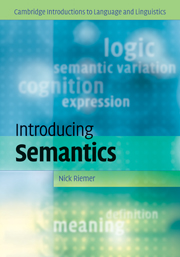Book contents
- Frontmatter
- Contents
- Note to the reader
- 1 Meaning in the empirical study of language
- 2 Meaning and definition
- 3 The scope of meaning I: external context
- 4 The scope of meaning II: interpersonal context
- 5 Analysing and distinguishing meanings
- 6 Logic as a representation of meaning
- 7 Meaning and cognition I: categorization and cognitive semantics
- 8 Meaning and cognition II: formalizing and simulating conceptual representations
- 9 Meaning and morphosyntax I: the semantics of grammatical categories
- 10 Meaning and morphosyntax II: verb meaning and argument structure
- 11 Semantic variation and change
- Glossary
- References
- Index
6 - Logic as a representation of meaning
Published online by Cambridge University Press: 05 June 2012
- Frontmatter
- Contents
- Note to the reader
- 1 Meaning in the empirical study of language
- 2 Meaning and definition
- 3 The scope of meaning I: external context
- 4 The scope of meaning II: interpersonal context
- 5 Analysing and distinguishing meanings
- 6 Logic as a representation of meaning
- 7 Meaning and cognition I: categorization and cognitive semantics
- 8 Meaning and cognition II: formalizing and simulating conceptual representations
- 9 Meaning and morphosyntax I: the semantics of grammatical categories
- 10 Meaning and morphosyntax II: verb meaning and argument structure
- 11 Semantic variation and change
- Glossary
- References
- Index
Summary
CHAPTER PREVIEW
Logic is the study of the nature of valid inferences and reasoning. The logical tradition constitutes one of the major strands in the study of meaning, and some knowledge of its background is indispensable in linguistic semantics. In this chapter we will study some basic logical tools and concepts. Our aim is twofold:
first, to understand the ways in which some types of meaning can be represented in logical symbolism
second, to appreciate the advantages and disadvantages of this type of representation.
We begin by introducing the ideas of validity, soundness and logical form (6.1): these define the context and aims of a logical approach to language. In 6.2 we present an exposition of the basic principles of propositional logic, the logic of basic sentences, including a treatment of the principal logical operators: and, not, or and if… then In 6.3 we discuss the extent to which these logical concepts overlap with the meanings of their ordinary language equivalents. Section 6.4 introduces predicate logic, the logic of expressions like some and all In 6.5 we discuss the ways in which the concept of a model allows us to describe reference using logical techniques. Section 6.6 contains a discussion of the sentence relations of entailment, presupposition and contradiction This leads to a discussion of meaning postulates in Section 6.7, which use the sentence relations introduced in 6.6 as part of a non-decompositional approach to meaning. In 6.8 Russell's theory of descriptions is discussed.
- Type
- Chapter
- Information
- Introducing Semantics , pp. 173 - 222Publisher: Cambridge University PressPrint publication year: 2010

